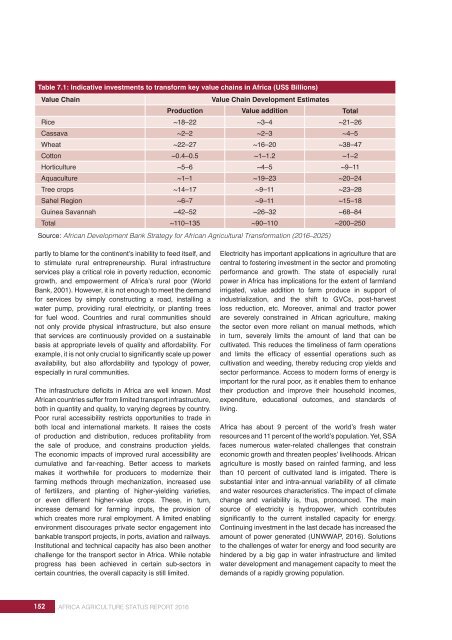AFRICA AGRICULTURE STATUS REPORT 2016
AASR-report_2016-1
AASR-report_2016-1
Create successful ePaper yourself
Turn your PDF publications into a flip-book with our unique Google optimized e-Paper software.
Table 7.1: Indicative investments to transform key value chains in Africa (US$ Billions)<br />
Value Chain<br />
Value Chain Development Estimates<br />
Production Value addition Total<br />
Rice ~18–22 ~3–4 ~21–26<br />
Cassava ~2–2 ~2–3 ~4–5<br />
Wheat ~22–27 ~16–20 ~38–47<br />
Cotton ~0.4–0.5 ~1–1.2 ~1–2<br />
Horticulture ~5–6 ~4–5 ~9–11<br />
Aquaculture ~1–1 ~19–23 ~20–24<br />
Tree crops ~14–17 ~9–11 ~23–28<br />
Sahel Region ~6–7 ~9–11 ~15–18<br />
Guinea Savannah ~42–52 ~26–32 ~68–84<br />
Total ~110–135 ~90–110 ~200–250<br />
Source: African Development Bank Strategy for African Agricultural Transformation (<strong>2016</strong>–2025)<br />
partly to blame for the continent’s inability to feed itself, and<br />
to stimulate rural entrepreneurship. Rural infrastructure<br />
services play a critical role in poverty reduction, economic<br />
growth, and empowerment of Africa’s rural poor (World<br />
Bank, 2001). However, it is not enough to meet the demand<br />
for services by simply constructing a road, installing a<br />
water pump, providing rural electricity, or planting trees<br />
for fuel wood. Countries and rural communities should<br />
not only provide physical infrastructure, but also ensure<br />
that services are continuously provided on a sustainable<br />
basis at appropriate levels of quality and affordability. For<br />
example, it is not only crucial to significantly scale up power<br />
availability, but also affordability and typology of power,<br />
especially in rural communities.<br />
The infrastructure deficits in Africa are well known. Most<br />
African countries suffer from limited transport infrastructure,<br />
both in quantity and quality, to varying degrees by country.<br />
Poor rural accessibility restricts opportunities to trade in<br />
both local and international markets. It raises the costs<br />
of production and distribution, reduces profitability from<br />
the sale of produce, and constrains production yields.<br />
The economic impacts of improved rural accessibility are<br />
cumulative and far-reaching. Better access to markets<br />
makes it worthwhile for producers to modernize their<br />
farming methods through mechanization, increased use<br />
of fertilizers, and planting of higher-yielding varieties,<br />
or even different higher-value crops. These, in turn,<br />
increase demand for farming inputs, the provision of<br />
which creates more rural employment. A limited enabling<br />
environment discourages private sector engagement into<br />
bankable transport projects, in ports, aviation and railways.<br />
Institutional and technical capacity has also been another<br />
challenge for the transport sector in Africa. While notable<br />
progress has been achieved in certain sub-sectors in<br />
certain countries, the overall capacity is still limited.<br />
Electricity has important applications in agriculture that are<br />
central to fostering investment in the sector and promoting<br />
performance and growth. The state of especially rural<br />
power in Africa has implications for the extent of farmland<br />
irrigated, value addition to farm produce in support of<br />
industrialization, and the shift to GVCs, post-harvest<br />
loss reduction, etc. Moreover, animal and tractor power<br />
are severely constrained in African agriculture, making<br />
the sector even more reliant on manual methods, which<br />
in turn, severely limits the amount of land that can be<br />
cultivated. This reduces the timeliness of farm operations<br />
and limits the efficacy of essential operations such as<br />
cultivation and weeding, thereby reducing crop yields and<br />
sector performance. Access to modern forms of energy is<br />
important for the rural poor, as it enables them to enhance<br />
their production and improve their household incomes,<br />
expenditure, educational outcomes, and standards of<br />
living.<br />
Africa has about 9 percent of the world’s fresh water<br />
resources and 11 percent of the world’s population. Yet, SSA<br />
faces numerous water-related challenges that constrain<br />
economic growth and threaten peoples’ livelihoods. African<br />
agriculture is mostly based on rainfed farming, and less<br />
than 10 percent of cultivated land is irrigated. There is<br />
substantial inter and intra-annual variability of all climate<br />
and water resources characteristics. The impact of climate<br />
change and variability is, thus, pronounced. The main<br />
source of electricity is hydropower, which contributes<br />
significantly to the current installed capacity for energy.<br />
Continuing investment in the last decade has increased the<br />
amount of power generated (UNWWAP, <strong>2016</strong>). Solutions<br />
to the challenges of water for energy and food security are<br />
hindered by a big gap in water infrastructure and limited<br />
water development and management capacity to meet the<br />
demands of a rapidly growing population.<br />
152 <strong>AFRICA</strong> <strong>AGRICULTURE</strong> <strong>STATUS</strong> <strong>REPORT</strong> <strong>2016</strong>


